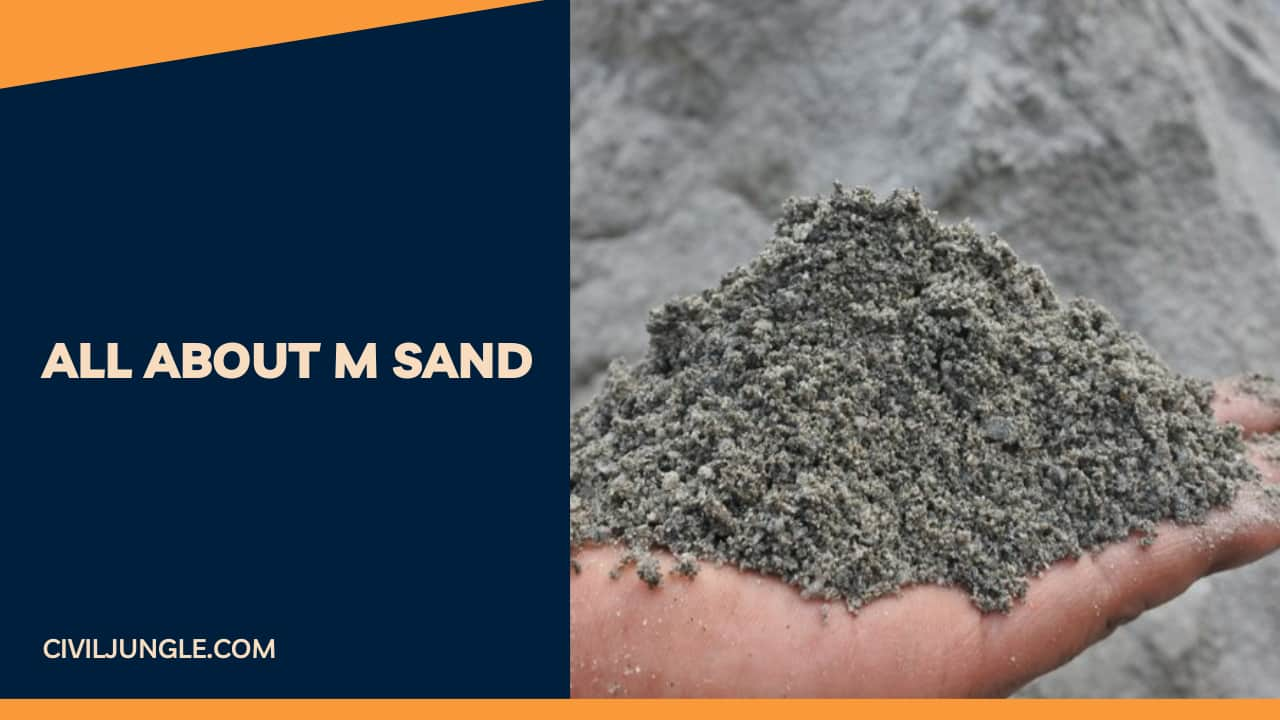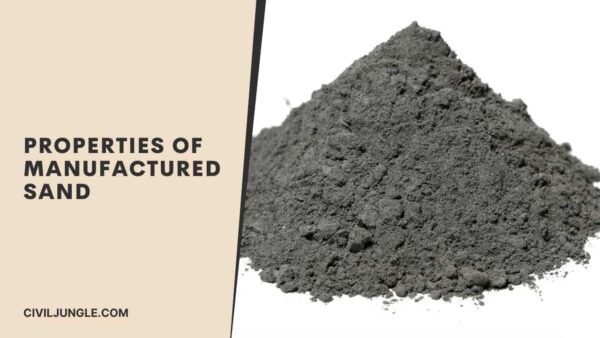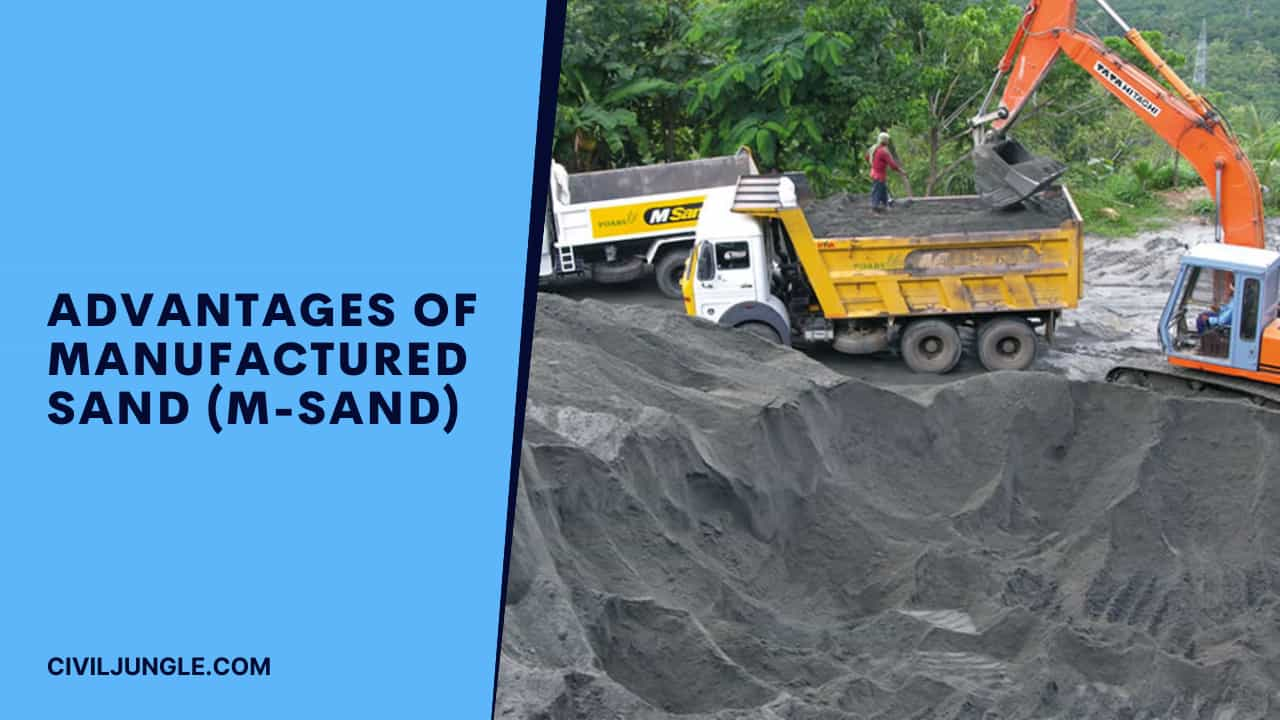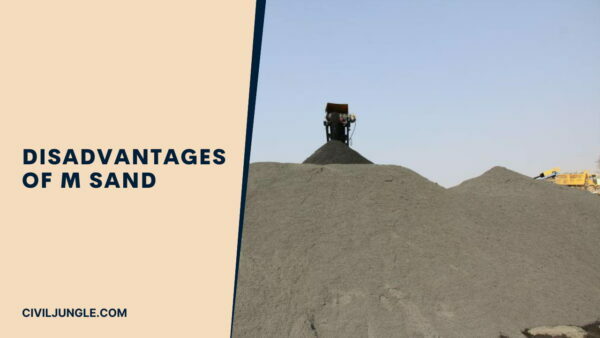What Is M Sand?
Important Point
Manufactured sand (M-Sand) is an additional of river sand for concrete structures. Manufactured sand is created as rigid granite stone by crushing.
The crushed sand is of cubical form with grounded boundaries, washed and classified as a building material. The extent of manufactured sand (M-Sand) is a reduced amount of 4.75 mm.
M-Sand is artificial sand manufactured from crushing hard gravel into minor sand-sized angular molded units, wash away as well as excellently graded to be used as building aggregate. It is a greater substitute for River Sand for building purposes.
Manufactured Sand (M-sand) is the utmost mutual alternative of river sand, which has previously added importance in approximately of the southern States. It is manufactured by crushing of rocks, quarry stones to a required size of 150 microns.
To reach the essential grain size, present rougher hard rock deposits are crushed in a sequence of crushers and the crushed material is separated into dissimilar portions as suitable to numerous building actions.
The sand acquired over this procedure is more advanced by eliminating fine particles and impurities finished sieving and washing.
The bulk density as well as specific gravity of together are similar as well as the chemical features and strength of M-sand are comparable to that of river sand as per IS-383. M-sand has a silt content of about 0.2% and water absorption of 1.6%, as associated with 0.45% and 1.15% correspondingly, in river sand
Owing to fast-rising manufacture industry, the claim for sand has improved extremely, producing lack of appropriate river sand in most portion of the word.
Owing to the reduction of good quality river sand for the use of construction, the use of factory-made sand has been improved. The alternative aim for use of M-Sand is its accessibility and transport cost.
Meanwhile manufactured sand can be crushed from hard granite rocks, it can be willingly accessible at the neighboring place, decreasing the cost of transportation from far-off river sand bed.
Consequently, the cost of construction can be measured by the use of manufactured sand as a substitute material for construction. The additional benefit of using M-Sand is, it can be dust-free, the sizes of m-sand can be measured effortlessly so that it encounters the mandatory grading for the specified construction.
Also, Read: What Is M Sand | Properties of Manufactured Sand | Advantages & Disadvantages of Manufactured Sand
Properties of Manufactured Sand
- The manufactured sand has an essential gradation of fines, physical properties such as shape, even exterior touches, and constancy which kinds it the greatest sand appropriate for construction. These physical properties of sand provide greater strength to the concrete by decreasing separation, bleeding, honeycombing, voids, and capillary.
- Accordingly essential grade of sand for the assumed determination helps the concrete fill voids amongst coarse aggregates and marks concrete added compact and dense, therefore increasing the strength of concrete.
- In the meantime, processed sand (M-Sand) is treated with the designated excellence of granite and has durable physical and chemical properties for the building of concrete structures.
- This feature of M-Sand allows the concrete structures to experience very environmentally sustainable conditions and prevents the weathering of reinforced steel by reducing permeability, moisture ingress, freezing-thaw effects of improving the longevity of concrete structures.
- Scale, form, touch plays a crucial role in the workability of the concrete. Due to the extra surface area of sand, the order for cement and water growth is made to guarantee sand with rough aggregates.
- The controller of these physical properties of the manufacture of sand marks the concrete that requires less water and delivers advanced workable concrete. Less use of water also helps from improving the consistency of concrete, less time to blend and settle the concrete, and thus improves the productivity of on-site building operations.
- Construction defects in the placement and post-concretion, such as separation, bleeding, honeycombing, voids, and capillarity in concrete, are minimized with the use of M-Sand, as it has the highest original and final set time as well as excellent fineness.
- Use of M-Sand has enhanced reliability, increased resilience, decreased isolation, permeability, improved workability, reduced post-concrete defects, and has seen to be cost-effective as a building material that replaces river sand.
- In many instances, the expense of transporting river sand may also be saved.
- The use of engineered sand avoids the dragging of river beds through river sand that could contribute to environmental disasters such as soil water pollution, water shortages, danger to the stability of bridges, dams, etc. to make M-Sands more eco-friendly than river sand.
- The outline of Crushed sand is cubicle and angular and has a rugged feel and is thus better for concrete.
- It does not contain silt when it is produced by grinding aggregates, although if the screening is not correct, it will often contain any dust.
- It does not contain any moisture.
- When used in concrete, the settling time of concrete is relatively quick.
- The compressive strength and flexicurity of the concrete made of m sand is stronger than the natural sand.
- When used as asphalt, the permeability of concrete is very low relative to the sand of the river.
- Made artificially, but there are no oversized materials.
- Water absorption of crushed sand is between 2 and 4 per cent.
- The slump of crushed sand is smaller than the slump of reverse sand.
- It does not include aquatic material.
- The bulk density of crushed sand is 1.75 g/cm3.
- The basic gravity of the crushed sand is 2.5 to 2.9 which varies on the parent rock.
- There is no need to correct bulking during the mixing design by using Crushed Sand in concrete.
- Ability of old surface moisture Crushed sand is up to 10%.
- It has less adulteration than the sand of the river
- It does less harm to the atmosphere than to real sand.
- It is of higher quality than natural sand since it is produced in a managed climate.
- It can be manufactured in the vicinity of the building site. Reducing shipping costs and providing and guaranteeing a steady supply.
- It is strongly recommended that RCC work on brickwork as well as blockwork.
- It’s affordable than sand. The amount of crushed sand is roughly 1000 per cubic metre.
Advantages of Manufactured Sand (M-Sand)
- It is well-rated in the appropriate proportion.
- It does not contain an organic and soluble compound that influences the timing and properties of the cement and thus the necessary strength of the concrete can be preserved.
- The presence of impurities such as mud, dust, and silt coatings does not increase the water demand, as in the case of river sand, which impairs the bond between cement paste and aggregate. Increased consistency and longevity of concrete.
- M-Sand is collected from real hard rock (granite) using state of the art international technologies, thereby obtaining the necessary sand property.
- M-Sand is cubic in shape and is produced using technologies such as high carbon steel hit a rock and then ROCK ON ROCK operation, which is synonymous with the natural process of river sand information.
- Modern and imported machines are used to manufacture M-Sand to maintain the appropriate sand grading field.
Also, Read: Density of Cement Sand and Aggregate | Cement Density | Sand Density | Aggregate Density | list of Density
Disadvantages of M Sand
- The workability of the M sand generated concrete is less than that of the natural said make. But this can be maintained by using a water-reducing mixture (Superplastsizer).
- The form of the sand of the river is rounded and has a flat finish. Apart from the form of M sand is a cubicle and Angular and has a rough texture due to this cement paste used to fill holes in concrete made using river sand is less than M sand. As a result, m sand needs more water and cement to reach the expected workability contributing to higher costs.
- The other drawbacks of M sand are that m sand produces greater quantities of micro-fine particles than natural sand in its manufacturing phase. Again, this will impair the quality and durability of the concrete.
- River sand, naturally available, has moisture stuck in its particles, which is needed for good concrete. In the other side, only M-Sand washed water preserves moisture.
- Due to its high demand, there are cases of M-Sand being adulterated with extraneous materials such as quarry mud.
- To confirm M-Sand is of the uppermost quality, it’s powerfully directed to put it finished a sequence of quality tests such as
-
- Adulteration Test
- Workability Test
- Rebound Test
- Slump Cone Test
Why Manufactured Sand is Used?
Manufactured sand or manufactured fine aggregate (MFA) is produced by reducing larger pieces of aggregate into sand-sized aggregate particles. Manufactured sands tend to be used in mixtures in areas where natural sand is not available or not cost-effective to be hauled to the needed location.
Properties of M Sand for Concrete Construction
Higher Strength: M Sand has a smooth surface texture and free from elongated and flaky particles as it is shaped by using VSI shaping machine. The cubicle-shaped particles provide greater durability, higher strength, and long life to the concrete.
Advantages of M-Sand
- Greater Durability: M-Sand has balanced physical and chemical properties that can withstand any aggressive environmental and climatic conditions as it has enhanced durability, greater strength, and overall economy. Usage of M-Sand can overcome the defects occurring in concrete such as honeycombing, segregation, voids, capillary, etc.
- High Strength: The superior shape, proper gradation of fines, smooth surface texture, and consistency in production parameter of chemically stable sands provides greater durability and higher strength to concrete by overcoming deficiencies like segregation, bleeding, honeycombing, voids, and capillary.
- Greater Workability: The crusher dust is flaky and angular in shape which is troublesome in working. There is no plasticity in the mortar which makes it even difficult for the mason to work, whereas the cubical shape with grounded edge and superior gradation gives good plasticity to the mortar providing excellent workability.
- Offsets Construction Defects: M-Sand has optimum initial and final setting time as well as excellent fineness which will help to overcome the deficiencies of concrete such as segregation, bleeding, honeycombing, voids, and capillary.
- Economy: Usage of M-Sand can drastically reduce the cost since like river sand, it does not contain impurities and wastage is NIL. In International Construction Scenario, no river sand is used at all, only sand is manufactured and used, which gives superior strength and its cubical shape ensures a significant reduction in the cement used in the concrete
- Eco-Friendly: M-Sand is the only alternative to river sand. Dredging of river beds to get river sand will lead to environmental disasters like groundwater depletion, water scarcity, a threat to the safety of bridges, dams, etc.
Disadvantages of M-Sand
- Crushed sand can be of coarser and angular texture. This can lead to more water and cement requirement to achieve the expected workability.
- Manufactured sand can contain larger amounts of micro fine particles than natural sand, This can affect the strength and workability of the concrete.
Properties of M-Sand
- Shape – Cubical
- Gradation – Controlled.
- Particle passing 75 micron – up to 15 percent
- Impurities – Absent
- Grading Zone – II( FM 2.6-3)
- Specific Gravity – 2.5-2.9
- Water Absorption – 2-4 percent
- Soundness – Relatively Sound (Ex. < 5).
- Alkali-Silica Reactivity – 0.001-0.008
CDE Solution for Manufactured Sand
CDE Asia provides pathbreaking solutions for combating growing shortages in natural sand, recovering value from low-grade minerals or rejects through beneficiation, and solving the age-old problem of industrial waste disposal, by offering novel recycling techniques to recover useful construction materials.
How is M Sand Made?
Manufactured sand (M–Sand) is a substitute of river sand for concrete construction. Manufactured sand is produced from hard granite stone by crushing. The crushed sand is of cubical shape with grounded edges, washed and graded to as a construction material.
Is M sand suitable for construction?
Manufactured sand (M–Sand) is artificial sand produced from crushing hard stones into small sand sized angular shaped particles, washed and finely graded to be used as construction aggregate. It is a superior alternative to River Sand for construction purposes.
Types of M sand
- M-Sand for Concreting: This M-sand is mainly used for concrete purposes.
- M-Sand for Plastering: This M-Sand is mainly used for Wall plastering and Tiling purposes.
- M-Sand for Brick / Block Work: This M-sand is mainly used for brick or block laying or for masonry work
Manufactured Sand Uses
M sand is a form of artificial sand, manufactured by crushing large hard stones, mainly rocks or granite, into fine particles, which is then washed and finely graded. It is widely used as a substitute for river sand for construction purposes, mostly in the production of concrete and mortar mix.
M Sand Full Form
Manufactured sand (M-Sand) is artificial sand produced from crushing hard stones into small sand sized angular shaped particles, washed and finely graded to be used as construction aggregate.
1 Unit M Sand Weight
1 unit river sand equals to 0.3865 kg.
M Sand Disadvantages
DISADVANTAGES OF M-SAND
- Crushed sand can be of coarser and angular texture. This can lead to more water and cement requirement to achieve the expected workability.
- Manufactured sand can contain larger amounts of micro fine particles than natural sand, This can affect the strength and workability of the concrete.
M Sand Properties
M sand vs river sand properties
- The shape of this artificial sand is cube-like or angular.
- It has a rough texture.
- The water absorption capacity of manufactured sand is 2% to 4%.
- As it is artificially produced, there are no oversized particles.
- There are lesser impurities in crushed sand compared to river sand.
M Sand Size
The size of manufactured sand (M-Sand) is less than 4.75mm. Contents: Why Manufactured Sand is Used?
M Sand Chemical Composition
M-sand, also known as manufactured sand, is a substitute for river sand in construction activities. Its chemical composition may vary slightly depending on the source and the manufacturing process. However, I can provide you with a general overview of the typical chemical composition of M-sand.
- Silica (SiO2): M-sand is primarily composed of silica, which is the main component of sand. Silica content in M-sand is usually high, ranging from 80% to 99%. Silica provides strength and durability to the construction materials.
- Alumina (Al2O3): M-sand may contain a small amount of alumina, typically less than 10%. Alumina can influence the setting time and workability of concrete.
- Iron Oxide (Fe2O3): M-sand may contain traces of iron oxide, which can impart a reddish color to the sand. However, the iron oxide content is generally low.
- Lime (CaO): Lime content in M-sand is usually minimal. It is present in the form of calcium carbonate and may contribute to the alkalinity of the sand.
- Magnesia (MgO): Magnesia content is typically low in M-sand. It can affect the setting time and strength development of concrete.
- Potassium Oxide (K2O) and Sodium Oxide (Na2O): M-sand may contain traces of potassium and sodium oxides, which are usually present as impurities.
Msand
M-sand, short for manufactured sand, is a type of sand that is produced from crushing rocks, quarry stones, or larger aggregates. It is an alternative to natural river sand and is widely used in construction activities, particularly in the production of concrete and mortar.
M Sand Status
To obtain the most accurate and up-to-date information on the status of M-sand, I recommend checking with local suppliers, construction authorities, or industry organizations in your specific region. They can provide you with the latest information on M-sand availability, quality standards, and any regulations or guidelines that may be applicable in your area.
M Sand Advantages and Disadvantages
Advantages of M-sand:
- Consistent Quality: M-sand is manufactured under controlled conditions using advanced technology, ensuring consistent quality and properties.
- Better Shape and Gradation: M-sand has a well-graded particle size distribution, which means it contains particles of various sizes. This results in better packing and improves the workability of concrete and mortar.
Disadvantages of M-sand:
- Lack of Natural Binding Properties: Unlike river sand, M-sand does not have natural binding properties. It may require the addition of chemical admixtures or other additives to improve the bonding between particles and enhance the workability of concrete.
- Higher Cost: In some regions, M-sand can be more expensive than river sand due to the costs associated with manufacturing, transportation, and quality control. The availability of M-sand may also be limited in certain areas, leading to higher prices.
M Sand Sieve Size
The sieve size is 150 microns (4.75 mm), which is the thickness of the granules. It is compliant with IS Code 383:1970.
What Is Manufactured Sand?
Manufactured sand (Man Sands or M-Sand) is sand produced from crushing rock or processing the by-products of materials from dry crushing operations. Introducing CDE’s washing equipment can transform these materials into sand with a high commercial value for a wide range of applications.
M Sand Gradation
The gradation of M-sand, or manufactured sand, refers to the particle size distribution of the sand. The gradation is an essential characteristic that affects the workability, strength, and durability of concrete and mortar. The specific gradation requirements may vary depending on the intended application and local construction standards. However, I can provide you with a general overview of the typical gradation of M-sand.
Like this post? Share it with your friends!
Suggested Read-
- House Construction Cost Calculator Excel Sheet
- What Is Pitched Roof | 8 Types of Pitched Roof | Advantages of Pitched Roof
- Floating Slab Vs Monolithic Slab | What Is Monolithic Slab | What Is Floating Slab
- Cinder Block Vs Concrete Block | What Is Cinder Blocks | What Is Concrete Blocks
- Cantilever Bridge | Cantilever Bridge Advantages and Disadvantages | Cantilever Bridge Facts
- What Is Zero Force Member for Truss | How to Identification of Zero Force Members in Truss
- Tributary Area | Tributary Area Examples | Tributary Width | Tributary Load | Tributary Area in Columns | Overview of Tributary Area
Originally posted 2023-05-17 14:55:26.






Leave a Reply